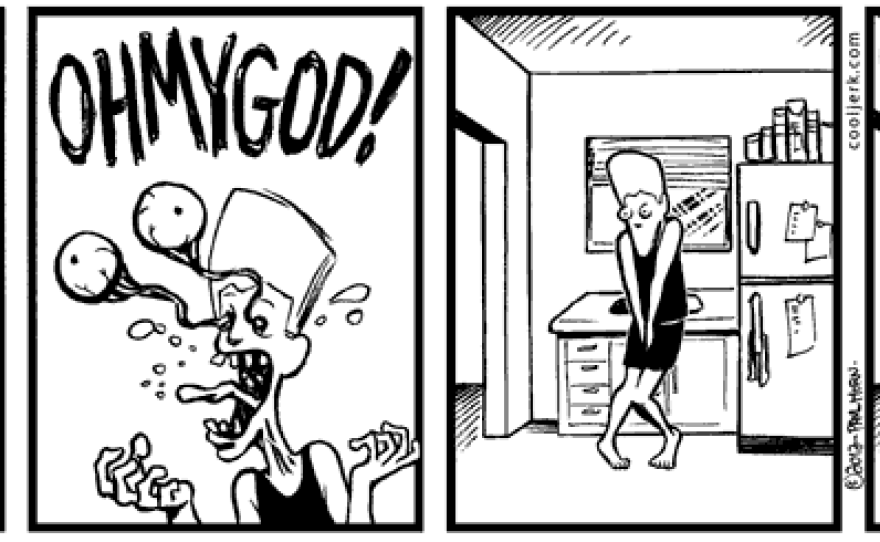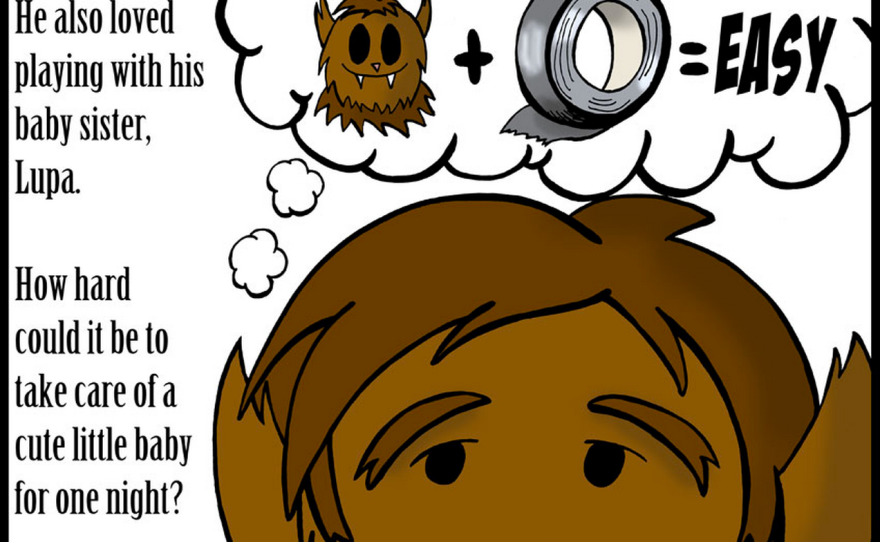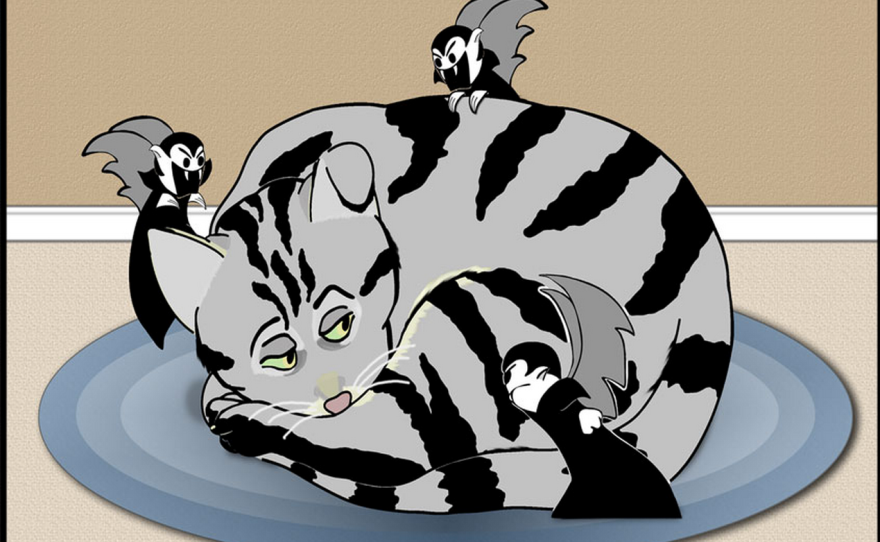ANCHOR INTRO: Webcomics are comics distributed online first. KPBS arts reporter Beth Accomando speaks with two San Diego artists about the impact webcomics have had on the industry over the past two decades. When the first webcomic debuted in 1985 it prompted a revolution in how comics could be distributed. Anyone with a computer and Internet access could put out a comic rather than having to submit it first to a syndicate or agent. REBECCA HICKS: It's a comic that didn't have to go through a syndicate, that didn't have to go through a filtering process, it's just out there for the world to see. And that was especially significant for women says Rebecca Hicks who creates the Little Vampires online comic. She says women cartoonists are a minority in print but are thriving in webcomics. REBECCA HICKS: If there was, and I'm not saying there was, but if there was any kind of we can't let the girls do comic strips attitude, it doesn't exist in web comics because there is no group of men or women saying uh, no yours is not really got wide appeal. Really we all throw our work up there and the stuff that's sticks is the stuff that's sticks but it's determined not by a small group of people but by the entire world in some cases. That access appealed to Paul Horn who creates Cool Jerk, a strip that originated in a Reno newspaper. PAUL HORN: Once the Internet started taking off, I took the strip out of print and put it online with the thought of the potential that anyone on the planet that has Internet access could then read my comic, which beats a hundred mile circulation radius. Plus it can reach that audience from anywhere. Both Hicks and Horn work out of San Diego, something that's easy to do now with today's technology. REBECCA HICKS: I don't even think easy is a strong enough term. For many people it was almost impossible to do certain kinds of work in entertainment because of location. But in the end what Hicks and Horn both produce is a comic strip. REBECCA HICKS: My elevator pitch for Little Vampires is they're literally little vampire and they try really hard to be like big and fierce vampires and they fail spectacularly at it. Horn writes and illustrates Cool Jerk. PAUL HORN: It's typically a four-panel strip that you would see in newspapers with recurring characters that makes a target of and pokes fun at a lot of the day to day banality of life, a lot of pop culture, current events, relationships, Southern California lifestyle. Cool Jerk is just one of the tens of thousands of webcomics now available online. Hicks points out that there's a difference between a print comic made available online and something that originates as a webcomic. REBECCA HICKS: Because that term to me means you are gonna have diversity of content, you are going to have diversity of art style whereas a comic book that has been put online it's gonna look just like the comic book in papers just on your iPad or whatever. I think the difference is in the innovation, this is the new technology, this is the new form of entertainment so that means that you are gonna see some new cool stuff. Part of that excitement comes from greater freedom for artists who are now their own bosses. There's no publisher or editor -- worrying about ads or circulation -- to tell them what they can or cannot do. But it also means there's not someone handing them a regular paycheck. PAUL HORN: It is not necessarily difficult to break into the industry but to make an income at it that's tough. Cool Jerk's website makes no money from ads or charging people to read the comics online. Instead, it's about getting and keeping fans, and selling other merchandise like books. PAUL HORN: I have 3 Cool Jerks books and a fourth one is coming out later this year. I have a side book called Doc Splatter: Ominous Omnibus, which is an advice column of the supernatural hosted by Doc Splatter -- think Dr. Phil with holy water and a chainsaw. But with all the new technology Hicks says she still builds her fan base one person at a time and often face to face at conventions. REBECCA HICKS: I met them, I talked with them, and they spread the word to their friends and nowI have friends of Little Vampires, in Germany. Not bad for creatures that are not much bigger than a computer mouse. Beth Accomando, KPBS News.
San Diego artists Paul Horn and Rebecca Hicks describe themselves as cartoonists. Hicks is the creator of "Little Vampires."
"'The Little Vampires' came from a random comment my husband made about his diabetes, about his finger tips, because he's always checking his blood sugar so he's like 'Yeah, my fingers look like they are being nibbled by little vampires.'
They are cute little vampires no more that 6 inches or so high says Hicks.
"My elevator pitch for 'Little Vampires' is they're literally little vampires. They try really hard to be like big and fierce vampires and they fail spectacularly at it."
Horn writes and illustrates "Cool Jerk."
"The easiest way for me to describe 'Cool Jerk' is that it's the exact opposite of 'Family Circus,'" says Horn. "It's typically a four-panel strip that you would see in newspapers with recurring characters that just sort of makes a target of and pokes fun at a lot of the day to day banality of life, a lot of pop culture, current events, relationships, Southern California lifestyle."
He also created "Doc Splatter."
"What that is, is another strip that I started in college called 'The Gore Score,' which is an advice column of the supernatural hosted by Doc Splatter -- think Dr. Phil with holy water and a chainsaw. Right now it's too dangerous probably for newspapers."
Which is fine because neither "Cool Jerk" nor "Little Vampires" appears in a newspaper. "Cool Jerk" and "Little Vampires" are web comics, which means they are published first online.
The first web comic (which is cited as "Witches and Stiches") debuted in the mid 80s but the format wouldn't take off for another decade. Now "Cool Jerk" and "Little Vampires" join tens of thousands of web comics currently available online.
But "Cool Jerk" did have its roots in the print world.
"Well my comic started in newspapers and specifically the 'Reno Gazette Journal,'" Horn recalls, "And so each week it would hit X number of subscribers or X number of copies that was in their circulation. Pretty limited. Once the Internet started taking off. I took the strip out of print and put it online with the thought of the potential that anyone on the planet that has Internet access could then read my comic, which beats a hundred mile circulation radius."

The online format means the traditional restrictions are no longer in place.
"When 'Cool Jerk' was a newspaper I really had to keep in mind that anyone could read this," says Horn, "And anyone would be in italics, that means little kids to grandparents."
Publishing his own comic on the web means Horn can push the envelope whenever he wants because there's no publisher -- worrying about ads or circulation -- to tell him otherwise.
For Hicks the new format was more about gaining access. In print, she says, there are only a handful of successful women cartoonists -- think Cathy Guisewite but not many more come to mind -- but online women are thriving.
"If there was, and I'm not saying there was, but if there was any kind of 'We can't let the girls do comic strips' attitude it doesn't exist in web comics because there is no group of men or women saying, 'Uh, no yours does not really have wide appeal.' Really, we all throw our work up there and the stuff that's sticks is the stuff that sticks but it's determined not by a small group of people but by the entire world in some cases and so those barriers are down."
And there's one more difference says Hicks -- "Innovation. This is the new technology, this is the new form of entertainment, so that means that you are gonna see some new cool stuff. I think web comics are way more exciting than comic books now and that's really hard for me to say."
Webcomics reveal a diversity of content and styles because anyone with a computer and Internet access can start their own site. That's very different from teh print world says Horn.
"I remember a statistic when I was thinking of getting 'Cool Jerk' in newspapers like where 'Bloom County,' and 'Far Side,' and 'Calvin and Hobbes' were in the late 80s. A syndicate sees something like 2000 submissions that come to his or her desk every year and they can only take on 2 or 3. With web cartooning -- so long as you have the ability to upload it to a site -- you are at eye level with anyone else on the planet. It is not necessarily difficult to break into the industry but to make an income at it is, that's tough."

In fact, Horn's "Cool Jerk" site is more about getting and keeping fans than generating income.
"I don't have any ads on my site," says Horn, "the site generates zero dollars, which is fine, I've been okay with that so to make the money to continue with following the dream and all that I publish books. There are 3 'Cool Jerk' books with a fourth due out soon. Each of the books has a director's commentary so that forces you to go back and re-read so you can go, 'Oh I never noticed that you never finished drawing her foot in that one strip?' Plus cool behind the scenes stuff, like here I am with a sidewinder rattlesnake and here's a piece of cheese that was mailed to me. And the index so you can look up the one with Pikachu or Amish ninja."
Hicks jokes that she took a rather backwards approach to launching her web comic.
"I started off with a book. Generally folks will put up a webcomic and then print a collection. And I just did it the way I did it, there are no rules in webcomics, there's what works and what doesn't work. Doing the book first and then going to webcomic is what worked for me."
Like Horn's "Cool Jerk," Hicks' website is not really a source of income even though she has limited advertising.
"My income comes through going to conventions and selling merchandise based on my work, selling art prints of my original art, and any little thing I can slap a little vampire on."
Or taking on commissions.
"This past year has really been my year for commissions. So things like logo design, I've done some like newspaper/magazine type covers [she did the 'CityBeat' cover the week of Comic-Con last year], I'm doing a picture book for a chiropractor, that's the nicest thing about the conventions is you never know who you are going to run into, I like your style, I'd like you to do some work for me, for me, I'm like I'd like you to pay, deal. It was awesome. Okay I never saw that one coming."
So even with all the new technology Hicks finds that the best way to build her business is one person at a time and often pressing the flesh in person at conventions. Hicks attends about 20 conventions a year. Horn only goes to a fraction of that. But both attend Comic-Con and both admit that even though they are working in new media they are still creating their art in old ways.
"A lot of web cartoonists generate a lot of what they do straight from the mouse to the Mac or the PC," says Horn,"And then they can upload it to a blog or onto a Tumblr account or any one of a number of online repositories for comics. But I still do my strip the way I have for nearly 25 years. And that is with brush and ink, pencil, brush, and ink."

Hicks works in similar fashion.
"So I start with the pencils and make sure everything, basically make sure everything fits, then I go over it with the ink pen. I use Photoshop for cleaning up lines and for the coloring. Eventually this will be a 'Little Vampires' webcomic. Wolfie is thinking about how easy it's going to be to babysit his baby sister. 'Baby plus duct tape equals easy.'"
Well not quite, and just like babysitting, a webcomic is not as easy as you might think.
Also check out my Geek Girl feature that includes Rebecca Hicks.







